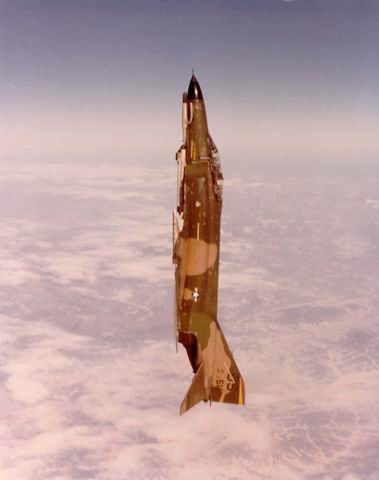While at the 36th TFS, Osan AB, ROK, I learned volumes about aerial combat, dogfighting, and edge of the envelope flying in the Phantom. One of the first things taught to me about dogfighting by the ďold headsĒ,was that if youíre not cheatin, you ainít tryin. Basically, this meant all things are fair when itís either you or that commie pr**k from up north when the balloon goes up (war time and fights on) and you were nose to nose for the initial merge. Let him die for his country, was the mantra. So, ingenuity, imagination, deception, and vicious overwhelming force were in order.
We typically bumped heads, i.e. Phantom v Phantom on a daily basis. Not a great MIG simulation but, all we had to work with. These were usually 1 V 1 or 2 V 2 setups. We would split up with 40 to 60 miles of separation, call ďReadyĒ and ďFights OnĒ. GCI (Callsign at Osan was ďBlue BoyĒ) was usually involved to give them practice working against a threat from the north. With an initial vector from Blue Boy (reminds me of a story about a bubble check for later) to get us pointed in the right direction, we would go from cruise power to MIL to full AB in one smooth motion. The twin J79s would do this all day and never hesitate. The WSOs (Weapons System Officers in the back seat) would sort target(s), provide vectors, and additional visual lookout for the merge and conversion.
A typical mission was briefed for a full up weapons load out (simulated), 4 X Radar missiles, 4 x IR missiles, and THE GUN. As we built up speed, transitioned through the Mach, and positioned for turning room at the merge, the WSOs had us locked for a Fox 1 (Radar Missile) in the lips. Fox 1 was called over the radio as it happened and then it was time to bleed airspeed for the initial turn and merge. A lot of Gs here as the turning fight developed and each jet jockeyed for a good Heater (IR Missile) Fox 2. These were more difficult in a hard turning fight because the IR seeker head had a limited field of view. As the seeker head started detecting a heat source we would get a sort of deep hissing sound in our helmet ear cups. When it had a good solid heat source it would transition to a solid growl. At that point it was time to let it fly, if within proper launch range.
Check out this link for a listen to the IR growl and how the missle operates.
https://youtu.be/axPJcdvJxLsDuring the merge part of the engagement, we transitioned from supersonic to subsonic, still with several hundred knots of airspeed, to a turning and most of the time vertical rolling scissors maneuver (commonly referred to as getting in the phone booth for a knife fight) that most often ended up with little to no speed on the airspeed indicator, in full AB. Now it was a waiting game and advanced handling event.

In initial MR (mission ready) training at Osan, my IP taught me to get a notch of flaps out as soon as airspeed limit would allow, stay in full AB, and park at deep six and close in on the other guyís burner cans, as he tried to out climb us. In this position the other dude could not see us and would start getting antsy trying to figure out where we were and what we were doing. Eventually, he would roll slightly for a peek and/or run out of airspeed and start to fall off in the vertical. Since I already had a notch of flaps out, my jet was slightly more controllable than his. At this point, it was a matter of an unloaded push of the stick and rudder to rotate down in the vertical as he was falling in full AB, trying to gain enough airspeed to maneuver against us. As we pointed down at his glowing orange tailpipes, the IR tone was a steady and robust growl. Fox 2, Kill, or if feeling especially vicious, gun his brains out.
As more guys learned this trick, the challenge was who would be the first to get that first notch of flaps out. Fighter pilots always want to be first. Going vertical in the phone booth was great fun and a great test of aircraft handling skills.
Then there was explaining to the crew chief why the stabilators were covered with black exhaust stain.